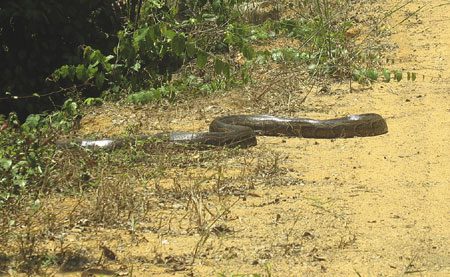Field Report: Sounds of Gabon—and a Few Sights
By Peter Wrege and Liz Rowland September 27, 2010



Grand Saline is a large bai, or clearing, and the focal area of Peter and Liz's study 

This is Petite Bai, a second study site where colleagues are also working 

Liz ran across this 15-foot python on the way in to the study area 

Eugene crosses a river by means of a fallen tree. Peter elects to wade. 

Peter sets up one of several "autonomous recording units" to begin the study 

Eugene monitors elephants for the Wildlife Conservation Society
One glossy python and eight automated recorders: those were the highlights we heard about this weekend from Peter Wrege and Liz Rowland. They’re spending the next six weeks recording elephants in Gabon—here’s post #2 from them:


Our primary objective is to find out what is really happening at night in forest clearings. The only previous observations have been done during full moon nights and without specialized equipment—and even this has been done rarely. From our sound recordings we know that most of the elephant activity occurs at night, but is that activity different from daytime? Are there different subsets of animals that come only at night (for example might the biggest bulls avoid clearings in the daytime because of the risk of being killed)?
In order to see in the dark, we are using night-vision binoculars (sensitive to infrared wavelengths) and a specialized LED floodlight that emits only in the infrared. Best of all, we are now entering the main phase of the project when we get to sit for hours on the platform and just observe and listen to all that is around us.
Here’s what the forest sounds like at morning, as a group of Black-casqued Hornbills wakes up:
Last night was our first overnight on the platform. It was both wonderful and instructive. We put white paint marks on some of the trees to help us estimate how big individual elephants are, but these were not very visible with the infrared binoculars. And boy is it hard to estimate size from up on a tower (looking down adds to the change of perception that comes with the darkness).
As far as birds go, in just a short while we saw African Finfoot, Hartlaub’s Duck, Black-casqued Hornbill, African Green Pigeon, African Pied Wagtail, African Pied Hornbill, African Grey Parrots, and heard lots and lots of birds that will keep us busy identifying them at times when elephant activity is low.


We’ve made many treks through the forest now, following Eugene (one of our Gabonese colleagues) in silence and single file, mainly using the network of elephant trails that crisscross this forest, often stepping in their immense footprints.
Eugene knows this forest well, and is constantly on guard for the tell-tale sounds of elephant. If he sees or hears one, we have to strictly obey his orders. As we wend our way through the undergrowth of shrubs and vines, all we see of the immense trees is their thick, straight trunks. Flowers are rare here, though a pink-flowering saprophyte is flowering now, as well as a white-flowered shrub whose beautiful scent perfumes the air.
The forest is more a place to hear animals than see them. Birds and primates call against a constant cacophony of frogs and insects. Our Gabonese colleagues can identify many of them. The “casque-noir” (Black-casqued Hornbill), is one of the more common ones. These large birds slowly flap and glide, often in pairs, around the forest, their wings making an odd sound rather like a slow helicopter. They have a confusing variety of calls, sometimes sounding more like ducks to me!
Meanwhile, the primates—mangobeys and putty-nosed monkeys—are hooting and hollering! There are crashing sounds, too, from animals going about their daily business, and from surprisingly frequent falling dead branches. At the moment, I’m just beginning to distinguish dead wood from the live animals (not saying much for an experienced zoologist!). Occasionally we’re treated to glimpses of smaller birds: an iridescent sunbird, brilliant blue kingfishers, and a flock of pretty red-billed finches.
“Arrette, arrette, python!” exclaimed one of our three Gabonese colleagues as we drove on the disused forestry road toward our work site, in a logging tract all-too-aptly named “Precious Woods.” A 5-meter-long python (not a very big one they said!) slowly slid back into the stream below.
Lying in my tent at night, the volume coming from the forest ramps up. The frogs and insects really get going, as well as a whole new collection of sounds: hooting owls, strange screeching tree hyraxes that seem to work themselves up into a frenzy, and many other mysterious calls. Last night though, I heard a sound that I did recognize: a distant trumpet. We’d all retired to our tents by then. Eugene whispered out to anyone still awake “Ah, l’elephant est la bas.” “Oui,” I replied, and smiled as I finally drifted off to sleep.
Read more about the trip:
- Elephants Visit Round Robin
- Gabon Update: Elephants Enter the Bai
- Gabon Update: Elephants Through Night Vision Glasses
- Gabon Update: 104 seconds with elephants
(Images by Peter Wrege and Liz Rowland. For more about this project, visit the Elephant Listening Project, or follow them on Facebook)


All About Birds is a free resource
Available for everyone,
funded by donors like you






